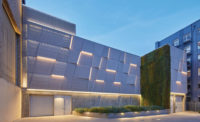If the national economy had been stronger a few years back, the six-story brick building at 185 Post Street in San Francisco would be long gone, replaced by a Rem Koolhaas–designed Prada boutique with thick walls of bead-blasted steel.
Instead, the masonry structure from 1908 has been restored to house offices above shops. Architecturally, though, the result is anything but a fastidious bow to the past. Quite the opposite: 185 Post Street is wrapped in a shroud of fritted glass set 9 inches out from the brick shell, which is now painted white.
“I go to museums and see glass encasements over beautiful artifacts, and I thought, ‘Why not try that?’ ” says Koonshing Wong, a principal in the San Francisco office of Brand + Allen Architects. “The goal was to touch the existing structure as lightly as possible with a new one.”
Brand + Allen was the architect of record for Koolhaas on his Prada “epicenter” that was to rise 10 stories as a provocative counterpoint to the Beaux-Arts-flavored landmarks of San Francisco’s retail district. That project was approved in 2001 but fell victim to changing times, and Prada finally sold the site to Grosvenor Properties in 2005.
In purchasing a prime commercial corner one block from Union Square, Grosvenor inherited an oft-altered 1908 building scarred finally by a 1950s tile facade. But because of budget, Brand + Allen’s marching orders were to work with what was there rather than start from scratch. That’s what led to Wong’s allegorical curtain wall, a glass case seemingly detached from the display inside.
Wong conceived of the glass as a sort of veil, opaque from some angles and transparent from others. After ruling out translucent glass, Wong settled on two patterns of fritted glass—a 60 percent transparency running horizontally beneath the windows and 40 percent in the vertical space between each opening.
The technical challenge was to translate an artistic notion into a physical element discreet and durable at once: “The thing that made us think a lot was how to have the connections dictated by the facade, rather than the structure behind it,” said David Murphy of Murphy Burr Curry, the project’s structural engineer. Tests determined that lightly braced panels could be no larger than 6 by 12 feet if they were to withstand the site’s wind load and a “maximum seismic event”—a euphemism for the tumultuous earthquake forecast to strike the Bay Area at some point in the future. The silver lining was that the need for seismic bracing offered an alternative to tying the new glass directly to the original walls. Instead, horizontal steel brackets are bolted to rods that extend from a new moment frame installed behind the 1908 walls. Except for the drilled holes that the rods pass through, the two systems are distinct.
While most of the glass is fritted, the square directly in front of the original window openings is clear. The openings are emphasized in another way, by glass frames that span the 9-inch gap between the two walls. The perpendicular pieces serve a structural role—subtly helping to tie back the new wall and offer reinforcement.
Because so much of the visual impact rides on the details, the team made alterations throughout the construction process. The design initially called for white caulking, for instance, but what looked subdued in the office drew attention to itself in full-scale mock-ups, catching sunlight with a vengeance. Black caulking is used instead, a steady presence that doesn’t jump out.
The biggest change involved the masonry: Instead of being left bare, it is now covered in a white epoxy paint that seals small fractures and gives the wall a uniform appearance.
“That’s not what we had planned—fritted white against heavy red would have been an interesting contrast,” Wong says with regret. “But the original walls were so beaten up, they had to be stabilized.” It also turned out that while most of the walls were red, the bricks around the windows were yellow.
Inevitably, the question that Wong hears most about 185 Post Street has nothing to do with design. It’s something more basic: How do you clean the space behind the glass?
You don’t.
The cavity isn’t airtight; there’s a vent with particle filters at the bottom of the curtain wall, above the ground floor. On the roof, the glass skin extends above the original brick structure and has fans attached to the back. They circulate air that prevents the cavity from heating up and warping the glass, but also keeps dust and dirt from settling down.










Post a comment to this article
Report Abusive Comment